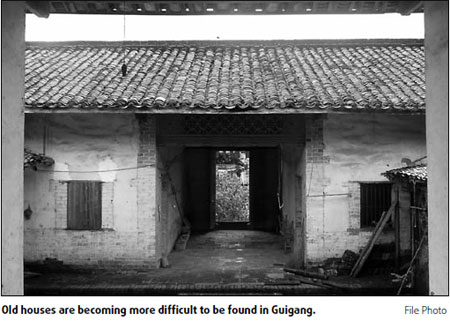
|
OPINION> Zhao Huanxin
 |
|
One man looks back while all around are looking ahead
By Zhao Huanxin (China Daily)
Updated: 2008-12-30 07:56
If you paint on a blank piece of paper, says a Chinese proverb, you may create a beautiful picture.
 This surely applies to Guigang, which has ushered in a torrid pace of urbanization over the past decade, since it was designated a city, east of Nanning, capital of Guangxi Zhuang autonomous region. While most of its 5 million residents are engaged in this frenzied effort of "painting new pictures" and designing a new city from scratch, local photographer Tan Chang is doing the opposite. "A photo says more than a thousand words about Guigang," says Tan, who has been chronicling the place for the last 20 years. "I hope my pictures will help retain the memories of a city on the cusp of change." Tan, 69, became an amateur photographer in 1985, when he worked at the Mianchi Xinhua Bookstore. Since then he has used equipment ranging from instamatic cameras to professional digital ones to capture a port city aiming to develop into a business and tourism hub in the southern part of Guangxi. Tan's apartment in downtown Guigang is literally a warehouse of photos depicting old buildings, street scenes, people and mountain views. The 20,000-plus pictures, stacked in shelves, are classified into several hundreds of albums, and for each photo Tan has written a caption and attached the negative to it. "I probably have more pictures about this city than anyone else, which is why editors of the city annuals and newspapers often come to me for a shot or two," Tan says. For the past decade, Guigang has witnessed an unprecedented construction boom. At the end of the 1990s, 55 million yuan ($8.2 million) was set aside to build New Century Square Park, which is as big as 16 football pitches. The city has also shelled out 1 billion yuan over the past two years to initiate a raft of projects, including fortifying a river embankment and improving urban infrastructure. None of the changes has slipped past Tan's lenses.
"I'm glad to see the city being reshaped into a modern one but many sites of historical significance are disappearing without trace," he says. "It is a pity that the city is bent on developing its economy through tourism but is also destroying something of historical and cultural value." A case in point is a fire-watch tower, standing four-stories high, which Tan shot in 2002. "It was probably built in the 1970s, giving firemen a sort of 'aerial view' of the whole of Guigang and allowing them to spot smoke that may develop into a fire," says Xiang Ruxin, former chief of Guigang's PR department and Tan's friend. "It was the tallest building in Guigang for a long time but was dismantled in 2005. No-one will have a chance to compare the size of present Guigang with its past." The two men are now writing a book on the history of Guigang, using Tan's photographs and Xiang's research and memories. Tan has also shot many pictures of run-down "gallery buildings" on the city's riverbank, unique structures in southern China with extended eaves to provide shelter for pedestrians. The gallery buildings have given way to the ongoing embankment fortification and beautification. Some of the dismantled gallery buildings were the setting for the 1989 hit movie Baise Uprising, about the 1929 revolution led by late Chinese leader Deng Xiaoping in Baise, Guangxi. "Director Chen Jialin failed to find adequate gallery buildings in Nanning for his movie, so when he heard that those in Guigang were in good condition, he brought his crew here," Xiang says. But those buildings now remain only in the movie - and in Tan's photos. Tan also shows off a group of pictures about an old printing house, whose blend of Chinese and Western architectural styles reveals the influence of missionaries who visited Guigang in the early last century. The printing house is now disused and will probably be demolished soon. Other old structures that exist only in Tan's albums and the memories of some senior citizens in Guigang include a desolate trade union building which once served as a hospital; a tonic drink house, popular in the 1940s for business people; and a church, whose bell once tolled to tell the time to dwellers of a whole town. Guigang's residents will continue painting rosy pictures about the city's future but Tan's old pictures will also offer lessons from the past. |